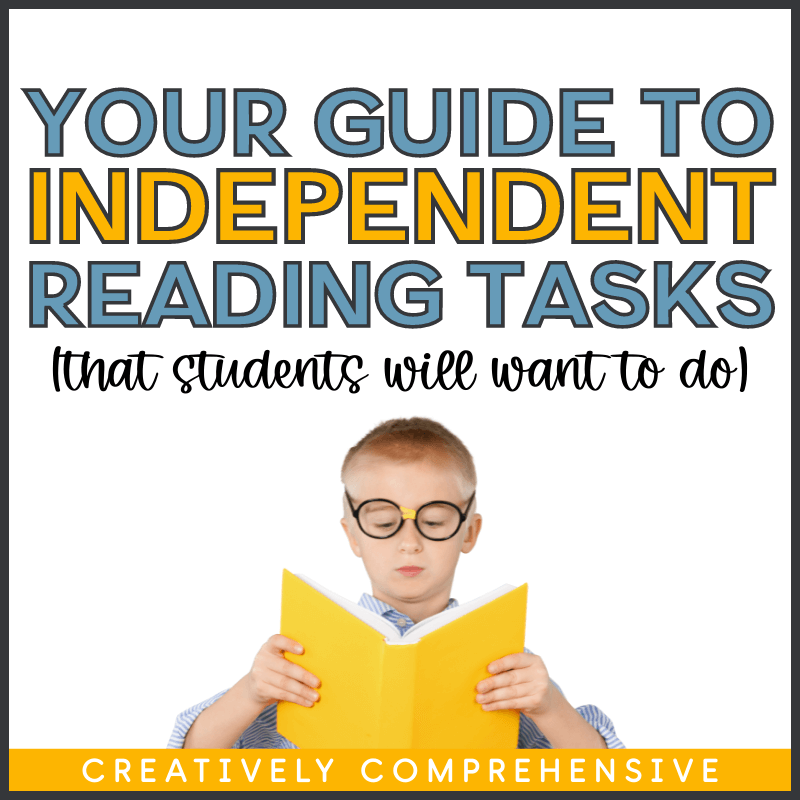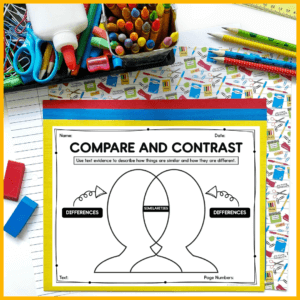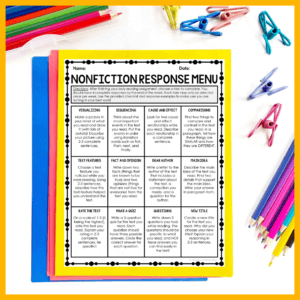Independent reading time is an essential component of your ELA block, but how can we make sure students stay on task? Much like any other routine, it involves a lot of modeling, scaffolding, and practicing. By following this how-to guide, your students will be able to complete their daily independent reading tasks effectively!

Have you ever been in this situation? You’ve worked on cause and effect for two weeks. You’ve made cause-and-effect foldables. You read stories with cause-and-effect examples. You used a graphic organizer to point out cause and effect in daily life. But when your students take a benchmark assessment on cause and effect…they completely bomb it.
I’ve been a part of many data meetings (both as a teacher and as a coach) where this above scenario played out. As a teacher, it took many years of trial and error before I realized the problem. As a coach, it became the first question I would ask the teacher: “Are your students working on the skill independently?”
Our students must read and apply skills and strategies on their own. However, when I posed that question as a coach, I would hear things like:
- (This group) can’t handle independent work.
- I don’t have time to include that in the schedule.
- I can’t get quality work from my students unless I am actively monitoring them.
These are all valid concerns! However (especially my upper elementary pals), I want you to think about one thing:
Do you want the first time your students read and analyze text independently to be on testing day?
I’m going to guess that you answered, “no.” So let’s get started! Here’s how to get your students to complete independent reading tasks capably and effectively:
Getting Prepared
You probably know it’s not the best idea just to say, “Okay class, if you aren’t meeting with me at the reading table, you can read on your own” and just leave it at that. With that approach, I can guarantee that most of your students will not be reading!
Step 1 is explaining to students the difference between reading for pleasure and completing independent reading tasks.
We WANT our students to enjoy reading just for the sake of reading, but we NEED our students to be able to read and comprehend on their own in order for us to truly assess their understanding of skills and standards.

Before you introduce independent reading tasks to your class, make sure they know how to pick out an appropriate book, explain the difference between “real” and “fake” reading, and understand that there will be a purpose to their independent reading in class.
Scaffold, Scaffold, Scaffold
There are times in education when we want to throw our learners into the figurative deep end to see if they can swim, but this is not one of those times! Every minute of instructional time is precious, and your readers need to spend their time wisely.
Once you feel your students understand the purpose of independent reading time, you can start practicing. To begin with, I would allow the whole class to find a comfortable spot to read, and then give them no more than 7-8 minutes to read their book. Tell your students they need to be prepared to share a notable sentence they read during this session with a partner. Once time is up and your readers have shared, debrief by going over positives you noticed and anything that needs to be adjusted for next time. Practice for a week or so, increasing the time slightly each day.
This routine will help students understand they will be held accountable for how they spend their reading time. While you work on this procedure, students answer orally to get them ready for the next step- written response.
Let’s Practice
While you are working on your expectations for independent reading, you can also set your students up to respond to reading successfully. In whole group, start devoting some time to using graphic organizers to respond to reading. I have a great set you can grab here! Use a familiar or shared text, and model exactly what to write in each section of the graphic organizer. Stick with the skill you are covering in your scope and sequence- for example, if you are working on comparisons, use a graphic organizer that will help students compare and contrast text.
Once students are familiar with that particular style of graphic organizer, have them fill one out for the text they are currently reading independently. When you meet in small groups (or do student reading conferences), you can have them discuss what they wrote down to measure their understanding of the skill.
If you continue to follow this format (introduce in whole group, practice independently, review in small group), not only are you not disrupting the flow of your block too much, you are making sure students have time to practice independently reading with a purpose each day. Once you have introduced a few different skills and strategies, your students will be ready to read and respond independently, without your assistance!
Time to Fly
We are almost to our goal- students completing independent reading tasks with success! However, they still need a bit of guidance before you send them off. A response menu is a great way to keep students on track (you can grab my FREE Nonfiction Response Menu here). This way students can choose the activity that pairs best with their current reading. As a bonus, the menu task provides guidelines to keep them on task!
If you’d like more tips for setting up a response journal, head to this blog post.
Continue the routine of looking at their response journals during conferences or small groups- it’s a great way to get an idea of how well your students are doing with their independent reading.
Independent Reading Task Success
It’s going to take a few months…but with the right amount of effort and scaffolding, your students will be able to write clear, detailed reading responses- independently! You will be amazed at how daily independent reading practice helps your students when it comes to assessments.
Free Graphic Organizers
These organizers were designed specifically to scaffold independent reading in your class! You can grab them by clicking on the picture below:
What are your best tips for independent reading success? Let me know in the comments.
Happy teaching!
Marianna



